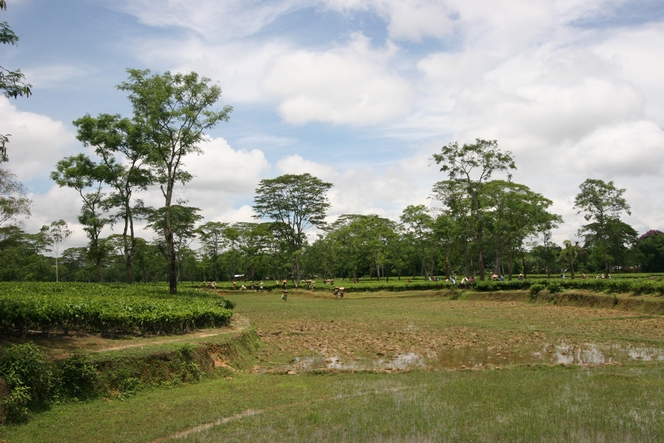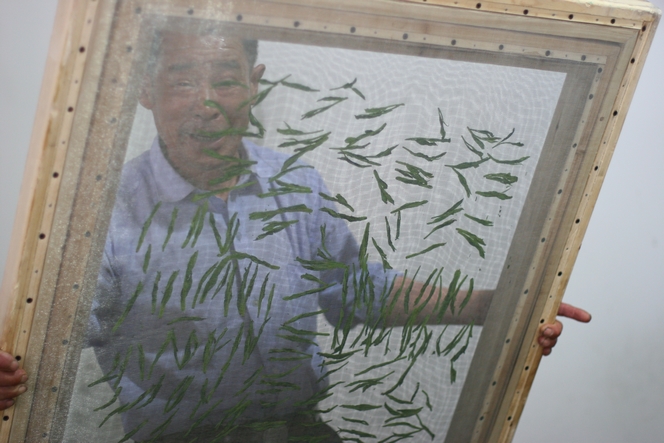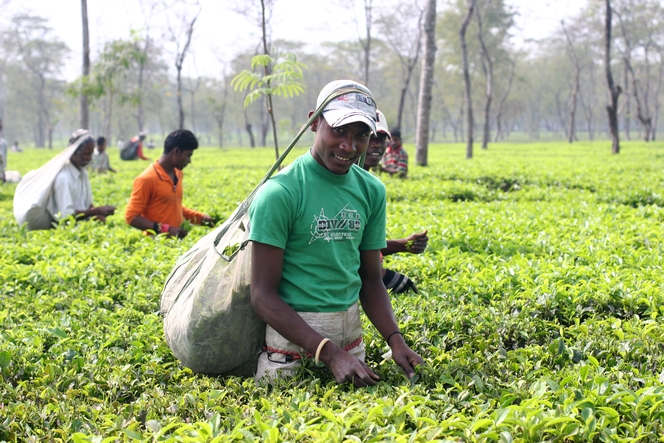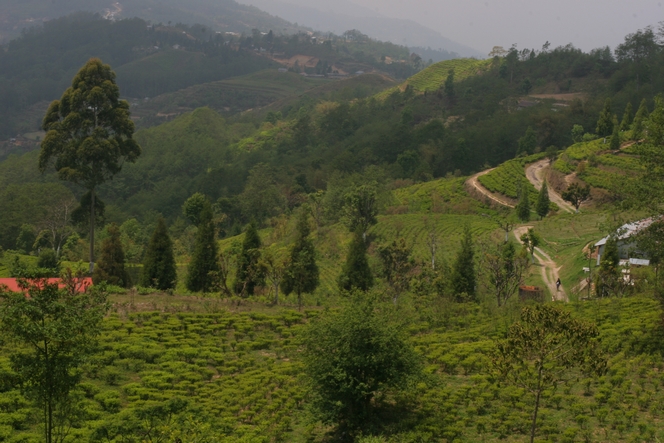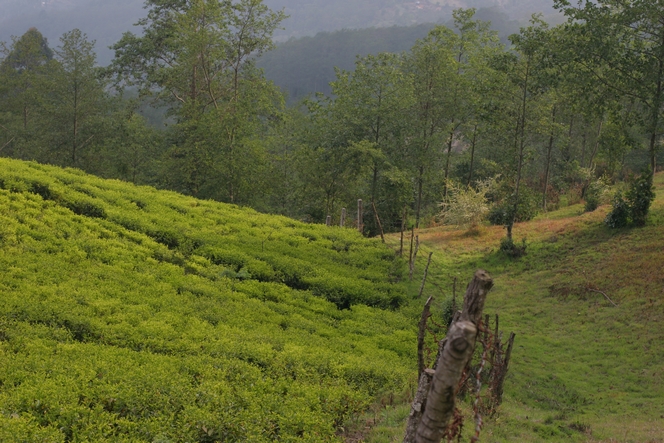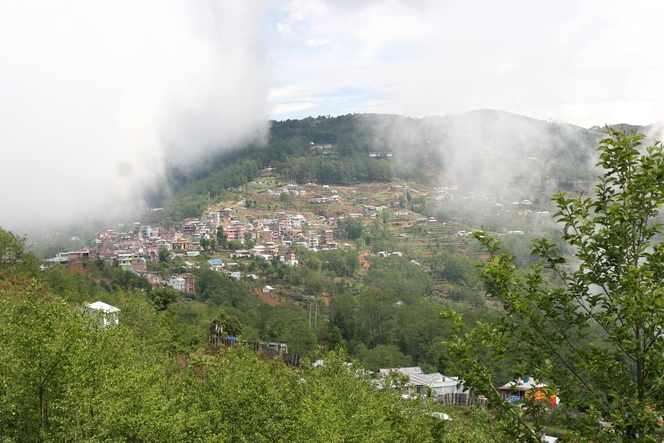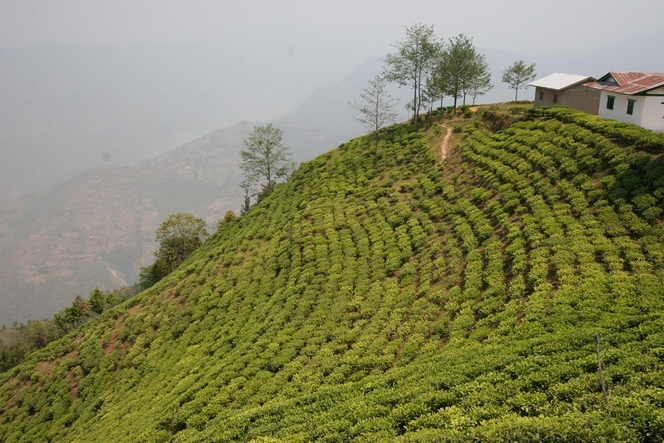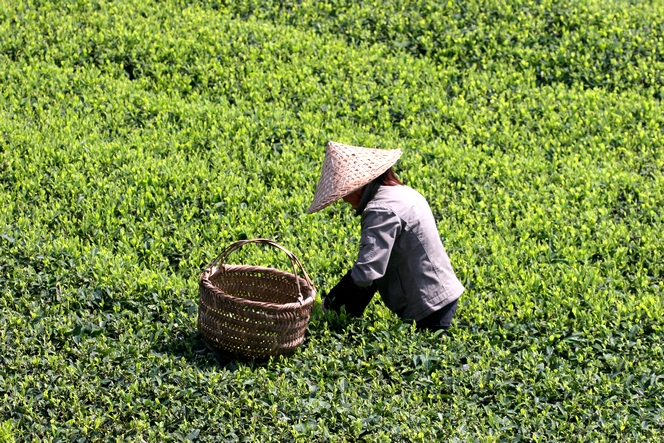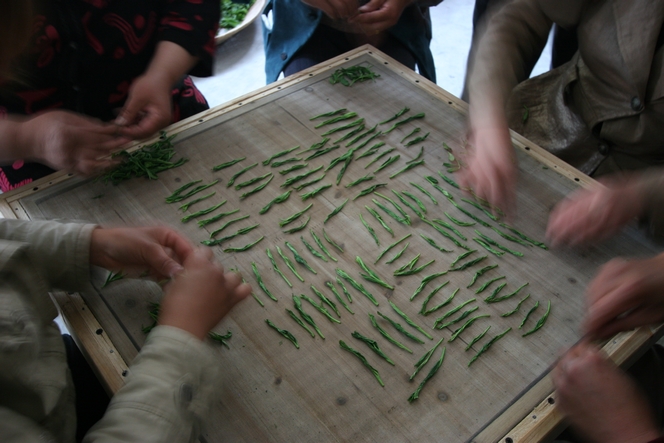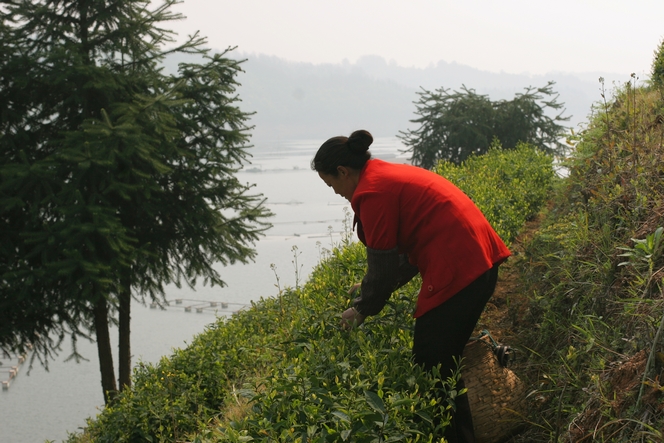For years, I dreamt of just one thing: to go to Assam and see the famous tea plantations. And here I am! The political situation has greatly improved, and it is now possible to travel around this state in the north-east of India, which is generously watered by torrential rains and by the Brahmaputra floods. Here, the tea fields adjoin the paddy fields. However, a slight difference in level separates them so that the water does not stagnate around the roots of the tea plants, but drains away into the paddy fields.
From plant to cup
Last stage in the processing of Taiping Hou Kui
After being fired, then rolled individually by hand, Taiping Hou Kui leaves are placed between two meshes. Moments later, the upper mesh is covered with a cloth and pressed with a roller, to flatten the leaves.
This painstaking task does not take place for any other tea. In this photo I took during my last trip to China, you can see how proud this producer is, preparing for the last stage in the processing of this fine green tea, the drying. The leaves you see here are held in place between the two meshes, and have just been flattened.
Tea harvesting by the Adivasis in India
In the Dooars region of India, tea is often harvested by the people known as the Adivasis. Often despised by other Indians because they are right at the bottom of the social ladder, they benefit from positive discrimination, along with the lower castes. They don’t get much attention, which is another reason to talk about them here.
The Adivasis are one of India’s biggest tribal populations. They descend from the aborigines and live in the north-east of the country.
I took this photo at Meenglas, near Mal Bazaar, a few kilometres from the border with Bhutan. The Dooars region doesn’t produce very good quality tea, but that’s not important here. It was the smiling faces of these workers that I wanted to tell you about, not the rather coarse leaves filling their bags.
Splendid view from Kuwapani tea garden
The plantations in the valley of Hile, in Nepal, were established recently. The oldest garden among Kuwapani, Guranse and Jun Chiyabari was created not much more than ten years ago. This might in part explain the quality of their tea, because the bushes they chose to plant on these mountain slopes are recent cultivars, famous for their aromatic properties. In addition, each of these plantations has developed innovative techniques for rolling the leaves, which is unusual in Nepal and India.
These three plantations are also special in that they are situated right next to each other. In this photo I took of Kuwapani, you can admire its splendid views, of course, but you can also see the red roof of the Guranse factory, close by.
Undisturbed tea trees in the setting sun
Last month a strike affected all of Nepal’s tea plantations, and for more than ten days the tea trees were left to grow undisturbed. This explains why, in this photo taken at Kuwapani, the delicate yellow colour of the new shoots reflects the light of the setting sun in such abundance. Over on the right of the fence, the grass is so closely shorn because the region’s many stags and roe deer have not joined in the movement, and show no signs of stopping work.
Makalu : the fifth highest peak in the world
I have just spent three days in the region of Nepal where the country’s best teas are produced. It is a valley to the east of Kathmandu from where, on a clear day, you can see the fifth highest peak in the world, Makalu.
The tea in this high valley is produced by just three plantations: Kuwapani, Guranse and Jun Chiyabari, all equally prestigious. They are situated right next to each other, at an altitude of around 2 000 metres, and this is the village of Hile, opposite.
In three days, I have only enjoyed such a clear view of this village twice, despite it being just a few hundred metres away. So I’ll have to come back another time to see Makalu!
The best teas are often produced from March to May
Some regions produce their best teas during the period from March to May. So this is a good time to meet the farmers and planters and see them at work.
I have left China for Nepal, which has been producing excellent teas in the past few decades. While here, I am visiting tea plantations in Hile (Kuwapani, Guranse, Jun-Chiyabari) located in the district of Dhankuta in Eastern Nepal, the most prestigious in the country.
Tea leaves ready for harvesting are yellow-green
You can tell when the tea leaves are ready for harvesting by the colour of the bushes. When the tea plants take on this yellow-green shade it means the new shoots have reached a good size and it is time to get out your basket and start plucking.
Here, you can see the difference in colour between the leaves that have not yet been harvested, in the background, and what remains on the plants after a visit from this Chinese woman, with her agile hands, in the foreground.
Taiping Hou Kui is incredibly labour-intensive
Processing Taiping Hou Kui is incredibly labour-intensive. Each leaf, after firing, is hand-rolled lengthwise and placed on a cloth. The leaves are carefully spaced out and then pressed with a small roller, leaving them flattened and larger.
Taiping Hou Kui : a very expensive tea from China
Taiping Hou Kui is harvested for just 25 days a year, generally between 20 April and 15 May. For the rest of the year the tea plant is allowed to grow without having its leaves plucked. This concentrates the harvest on the best season.
Mrs Zha has a pretty plot of land on the edge of lake Taiping. She is very busy during this plucking period. Taiping Hou Kui is one of the most expensive teas in China, and its price can reach thousands of yuan per kilo.

